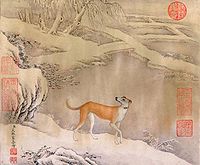Ignaz Sichelbarth
Ignaz Thaddäus Wenzeslaus Sichelbarth , also Sickelbart, Sickelpart ; Chinese 艾 啓蒙 / 艾 启蒙 , Pinyin Ài Qǐměng ; (Born September 26, 1708 in Neudek ; † October 6, 1780 in Beijing ) was a Bohemian Jesuit , missionary and painter who was raised to the rank of Mandarin .
Life
Ignaz Sichelbarth was born as the fourth child of the taker Judas Thaddäus Sichelbarth and his wife Francisca Maximiliana in Neudek in the Ore Mountains . His father, who was employed by the Czernin rulers in Neudek from 1705 to 1715, was already active as a painter. So around 1696 he made four large oil paintings for the town hall in Elbogen . The two paintings still preserved are now in the Elbogen parish church of St. Wenceslaus. Sichelbarth's grandfather was the town clerk, schoolmaster, cantor and border customs collector Theodor Sichelbarth († 1710) who had been employed in Bergstadt Platten since 1669 .
After his novitiate in Brno , Sichelbarth began studying theology at the University of Olomouc in 1739, which he finished in 1741. Finally, at his own request, he was sent to China as a missionary by the order's leadership in 1745 . At the Qing court in Beijing, Sichelbarth worked primarily as a painter together with his friars Giuseppe Castiglione and Jean-Denis Attiret . The Jesuits made Western painting known there, but also combined elements of European art ( central perspective , Chiaroscuro technique) with traditional Chinese painting in their own works , thus developing a new style, the so-called Qinghof style. Together they created the famous cycle The ten victorious campaigns of Emperor Qianlong , which was engraved in copper in the workshop of Charles-Nicolas Cochin in Paris around 1770 and sent back to the Chinese imperial court from there. After the death of his two famous confreres in 1768, Sichelbarth was promoted to head of mission, director of the Imperial Painting Academy and court painter to Emperor Qianlong.
Like other leading court Jesuits, Sichelbarth remained largely unaffected by the fight against Christian missionaries, which was established after Pope Benedict XIV's final ban on accommodation ( rite dispute ) in 1744. In 1778 he was raised to the mandarin rank. Most recently, Sichelbarth suffered from wear and tear on both shins, probably from knee osteoarthritis. He was redeemed from his suffering on October 8, 1780 at the age of 73.
Honors
Sichelbarth's tombs are located in the Jesuit cemetery Zhalan in Beijing. The appreciations were engraved in Latin and Chinese (excerpts from the Chinese text :)
... he came from the land of Bohemia in the great west ... A long-cherished wish came true for him when he came to China to spread the (Christian) teaching ... (1745) he became because of his excellent Skills as a painter appointed by the emperor in the capital. For many years he worked with zeal to the great satisfaction of the emperor in the Ruyi Institute (the academy in the imperial palace). Therefore, he repeatedly received signs of imperial appreciation and generous gifts. So he was appointed first director of the administration of the imperial parks and received the salary of a third class mandarin.
In the 42nd year of the Qian Long government (1777), he was honored with an official 70th birthday celebration. He was handed a plaque on which the emperor had written the words: Long life (for a guest) from a distant land. There are few words to describe the respect he has earned for his impeccable way of life. He was especially known for his practice of the virtues of persistence and patience. He died ... (October 6, 1780) at the age of 73. After his death, the emperor donated 200 silver tael from the imperial treasury to cover the costs of his funeral.
literature
- Constantin von Wurzbach : Sichelbart, Ignaz . In: Biographisches Lexikon des Kaiserthums Oesterreich . 34th part. Imperial-Royal Court and State Printing Office, Vienna 1877, p. 209 f. ( Digitized version ).
- Rudolf Grulich: The contribution of the Bohemian countries to the world mission of the 17th and 18th centuries , 1981 ISBN 3-921-34410-7
- Erich Zettl : Ignaz Sichelbarth 1708–1780 Missionary, painter and mandarin at the Chinese imperial court . Konstanz University of Technology, Economics and Design, Konstanz 2011.
Individual evidence
- ^ Karl Maria Swoboda: Baroque in Bohemia . Prestel-Verlag, 1964 ( google.de [accessed May 30, 2017]).
- ↑ New general artist Lexicon: or messages from the life and works of painters, sculptors, architects, engravers etc . EA Fleischmann, 1846 ( google.de [accessed May 30, 2017]).
| personal data | |
|---|---|
| SURNAME | Sichelbarth, Ignaz |
| ALTERNATIVE NAMES | Sickelbart, Ignaz; Sickelpart, Ignaz; Ai, Qimeng |
| BRIEF DESCRIPTION | German missionary |
| DATE OF BIRTH | September 26, 1708 |
| PLACE OF BIRTH | Neudek (Bohemia) |
| DATE OF DEATH | October 6, 1780 |
| Place of death | Beijing , China |

